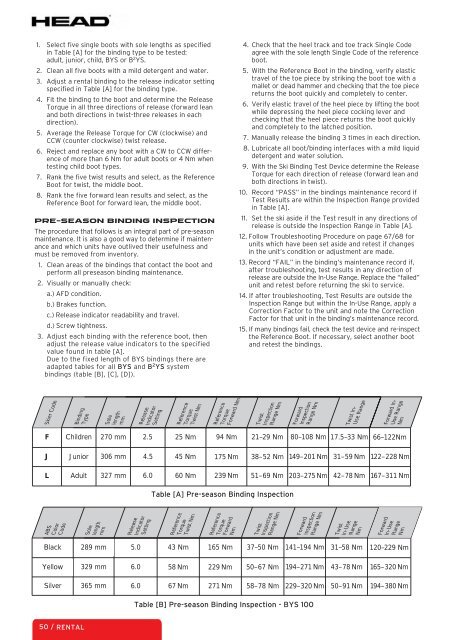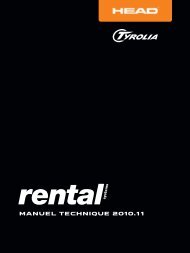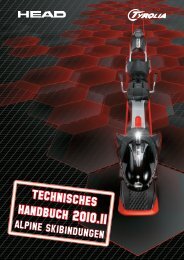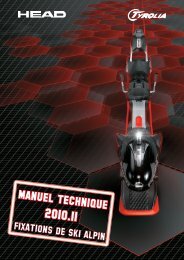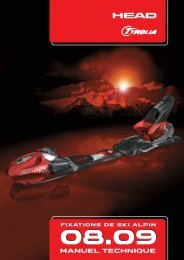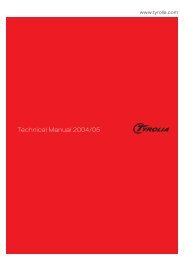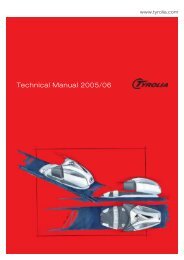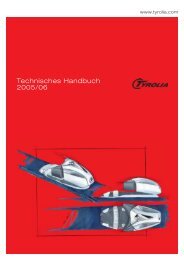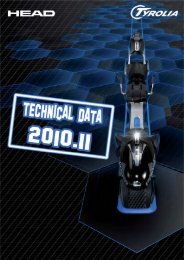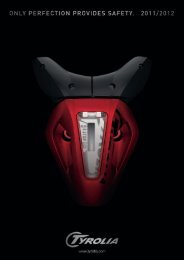You also want an ePaper? Increase the reach of your titles
YUMPU automatically turns print PDFs into web optimized ePapers that Google loves.
1. Select five single boots with sole lengths as specified<br />
in Table [A] for the binding type to be tested:<br />
adult, junior, child, BYS or B2YS. 2. Clean all five boots with a mild detergent and water.<br />
3. Adjust a rental binding to the release indicator setting<br />
specified in Table [A] for the binding type.<br />
4. Fit the binding to the boot and determine the Release<br />
Torque in all three directions of release (forward lean<br />
and both directions in twist-three releases in each<br />
direction).<br />
5. Average the Release Torque for CW (clockwise) and<br />
CCW (counter clockwise) twist release.<br />
6. Reject and replace any boot with a CW to CCW difference<br />
of more than 6 Nm for adult boots or 4 Nm when<br />
testing child boot types.<br />
7. Rank the five twist results and select, as the Reference<br />
Boot for twist, the middle boot.<br />
8. Rank the five forward lean results and select, as the<br />
Reference Boot for forward lean, the middle boot.<br />
PRE-SEASON BINDING INSPECTION<br />
The procedure that follows is an integral part of pre-season<br />
maintenance. It is also a good way to determine if maintenance<br />
and which units have outlived their usefulness and<br />
must be removed from inventory.<br />
1. Clean areas of the bindings that contact the boot and<br />
perform all preseason binding maintenance.<br />
2. Visually or manually check:<br />
a.) AFD condition.<br />
b.) Brakes function.<br />
c.) Release indicator readability and travel.<br />
d.) Screw tightness.<br />
3. Adjust each binding with the reference boot, then<br />
adjust the release value indicators to the specified<br />
value found in table [A].<br />
Due to the fixed length of BYS bindings there are<br />
adapted tables for all BYS and B2YS system<br />
bindings (table [B], [C], [D]).<br />
F<br />
Skier Code<br />
Binding<br />
Type<br />
J Junior 306 mm 4.5 45 Nm 175 Nm<br />
L Adult 327 mm 6.0 60 Nm 239 Nm 51–69 Nm 203–275 Nm<br />
ABS<br />
Color<br />
Code<br />
Black<br />
Yellow<br />
Children<br />
50 / RENTAL<br />
Sole<br />
length<br />
mm<br />
289 mm<br />
Sole<br />
length<br />
mm<br />
270 mm<br />
Release<br />
Indicator<br />
Release<br />
Indicator<br />
Setting<br />
Reference<br />
Torque<br />
329 mm 6.0 58 Nm<br />
Twist Nm<br />
Reference<br />
Torque<br />
Forward Nm<br />
4. Check that the heel track and toe track Single Code<br />
agree with the sole length Single Code of the reference<br />
boot.<br />
5. With the Reference Boot in the binding, verify elastic<br />
travel of the toe piece by striking the boot toe with a<br />
mallet or dead hammer and checking that the toe piece<br />
returns the boot quickly and completely to center.<br />
6. Verify elastic travel of the heel piece by lifting the boot<br />
while depressing the heel piece cocking lever and<br />
checking that the heel piece returns the boot quickly<br />
and completely to the latched position.<br />
7. Manually release the binding 3 times in each direction.<br />
8. Lubricate all boot/binding interfaces with a mild liquid<br />
detergent and water solution.<br />
9. With the Ski Binding Test Device determine the Release<br />
Torque for each direction of release (forward lean and<br />
both directions in twist).<br />
10. Record “PASS” in the bindings maintenance record if<br />
Test Results are within the Inspection Range provided<br />
in Table [A].<br />
11. Set the ski aside if the Test result in any directions of<br />
release is outside the Inspection Range in Table [A].<br />
12. Follow Troubleshooting Procedure on page 67/68 for<br />
units which have been set aside and retest if changes<br />
in the unit’s condition or adjustment are made.<br />
13. Record “FAIL” in the binding’s maintenance record if,<br />
after troubleshooting, test results in any direction of<br />
release are outside the In-Use Range. Replace the “failed”<br />
unit and retest before returning the ski to service.<br />
14. If after troubleshooting, Test Results are outside the<br />
Inspection Range but within the In-Use Range, apply a<br />
Correction Factor to the unit and note the Correction<br />
Factor for that unit in the binding’s maintenance record.<br />
15. If many bindings fail, check the test device and re-inspect<br />
the Reference Boot. If necessary, select another boot<br />
and retest the bindings.<br />
Twist<br />
Inspection<br />
Range Nm<br />
38–52 Nm 149–201 Nm<br />
Table [A] Pre-season Binding Inspection<br />
Forward<br />
Inspection<br />
Range Nm<br />
Twist In-<br />
Use Range<br />
31–59 Nm<br />
42–78 Nm<br />
Forward In-<br />
Use Range<br />
Nm<br />
2.5 25 Nm 94 Nm 21–29 Nm 80–108 Nm 17.5–33 Nm 66–122Nm<br />
Setting<br />
Reference<br />
Torque<br />
Twist Nm<br />
5.0 43 Nm<br />
165 Nm 37–50 Nm 141–194 Nm<br />
229 Nm<br />
50–67 Nm 194–271 Nm<br />
Silver 365 mm 6.0 67 Nm 271 Nm 58–78 Nm 229–320 Nm<br />
Reference<br />
Torque<br />
Forward<br />
Nm<br />
Twist<br />
Inspection<br />
Range Nm<br />
Forward<br />
Inspection<br />
Range Nm<br />
Table [B] Pre-season Binding Inspection - BYS 100<br />
Twist<br />
In-Use<br />
Range<br />
Nm<br />
31–58 Nm<br />
43–78 Nm<br />
50–91 Nm<br />
122–228 Nm<br />
167–311 Nm<br />
Forward<br />
In-Use<br />
Range<br />
Nm<br />
120–229 Nm<br />
165–320 Nm<br />
194–380 Nm


